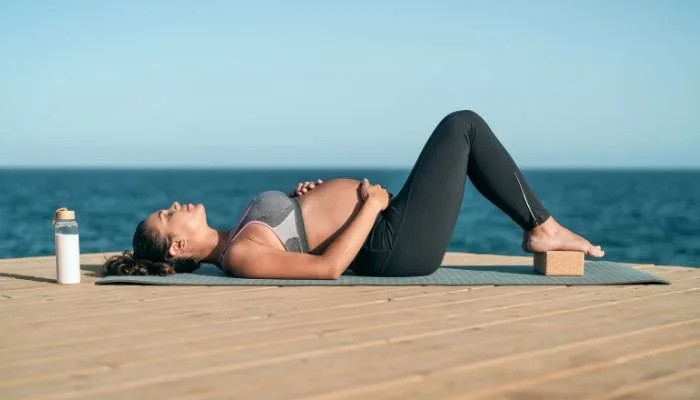5 Exercise Basics For Pregnancy: Simple Moves You're Overlooking
Staying active during pregnancy is not only safe but also beneficial for both you and your baby. In this article, we will explore five exercise basics that you might be overlooking, but that are all super beneficial to you throughout pregnancy to support your body, birth, and growing bump. Let's dive in!
What are the benefits of pregnancy exercise?
Exercising during pregnancy offers numerous benefits for both the mother and the baby. Regular exercise can help:
Improve cardiovascular health
Reduce the risk of gestational diabetes and high blood pressure
Aid in easing common discomforts associated with pregnancy, such as back pain and swelling
Some evidence suggests it can even help make labor and delivery easier! Read more about that here.
Is it safe to exercise during pregnancy?
Yes, it is generally safe to exercise during pregnancy. In fact, staying active can have numerous benefits for both the mother and the baby. The truth is, your baby is really well cushioned in your uterus. The amniotic fluid that surrounds baby acts like a shock absorber, so when you’re moving around, your baby is quite content within their cushioned little bubble. There’s no evidence that exercise harms baby during pregnancy – and in fact, the evidence strongly suggests otherwise (read more here, here, and here!).
It's important to get exercise clearance from your doctor before starting or continuing any exercise routine. They can provide guidance based on your individual health and circumstances and ensure that you choose exercises that are safe and appropriate for you and your baby. Listening to your body, avoiding high-impact exercises, staying hydrated, and taking breaks when needed are also important factors to consider when exercising during pregnancy.
5 exercise basics for pregnancy that you're probably overlooking
Pelvic floor exercises
What is the pelvic floor?
The pelvic floor refers to a group of muscles and tissues that form a supportive hammock-like structure at the base of the pelvis. These muscles play a crucial role during pregnancy and childbirth, as they support the bladder, uterus, and bowel.
Why are pelvic floor exercises important during pregnancy?
During pregnancy and childbirth, these muscles can become weakened. Pelvic floor exercises, also known as Kegels, can help strengthen these muscles and prevent or alleviate common issues such as urinary incontinence (leakage), pelvic organ prolapse (when the pelvic organs descend into the vaginal canal), and even problems with sexual function. Performing pelvic floor exercises regularly during pregnancy can also help prepare the muscles for labor and delivery.
To perform a Kegel exercise: simply contract the muscles you use to stop the flow of urine midstream and hold for a few seconds before releasing. Repeat this exercise several times throughout the day to strengthen your pelvic floor.
Bodyweight squat
Squats are an excellent exercise as they help strengthen the lower body muscles, including the thighs, hips, and glutes. They also promote good posture and balance, which can be beneficial during pregnancy when weight distribution is changing.
To perform a bodyweight squat: stand with your feet slightly wider than hip-width apart, toes pointing slightly outward. Bend your knees and lower your body down as if you are sitting back into a chair. Keep your chest lifted and your weight in your heels. Pause for a moment at the bottom before pushing through your heels to return to the starting position.
Modified Plank
Strengthening your core muscles is crucial during pregnancy and postpartum as they help support your growing belly and promote good posture. The modified plank exercise is a safe and effective way to engage your core muscles.
To perform a modified plank: Begin on your hands and knees, aligning your wrists with your shoulders and your knees with your hips. Extend one leg back, keeping it straight, and then do the same with the other leg. Hold this position for a few seconds while engaging your abdominal muscles. Remember to breathe steadily and avoid arching your back.
Hip Bridges
Hip bridges target the glute muscles, lower back, and core, which can become weakened during pregnancy and childbirth.
To perform a hip bridge: Lie on your back with your knees bent and feet flat on the floor, hip-width apart. Slowly lift your hips off the ground while squeezing your glutes and engaging your core. Hold this position for a few seconds before lowering your hips back down. Perform several repetitions to strengthen your glutes and improve lower back stability.
Upper Back Stretch
As your baby grows, your upper back may become tight and tense, leading to discomfort. This simple stretch helps alleviate tension and improve posture.
To perform an upper back stretch: Stand tall with your feet hip-width apart. Clasp your hands in front of you, palms facing outward, and arms extended. Gently round your upper back, pushing your hands away from your body, until you feel a stretch in your upper back and shoulders. Hold the stretch for 15-30 seconds and repeat as needed.
The takeaway
In conclusion, incorporating these basic exercises into your fitness routine can greatly benefit your overall well-being. The modified plank exercise engages your core muscles and promotes good posture, while hip bridges target the glutes, lower back, and core. Additionally, the upper back stretch helps alleviate tension and improve posture as your baby grows. Remember to consult with your healthcare provider before starting any new exercise program during pregnancy. Stay active and take care of your body throughout this incredible journey.

